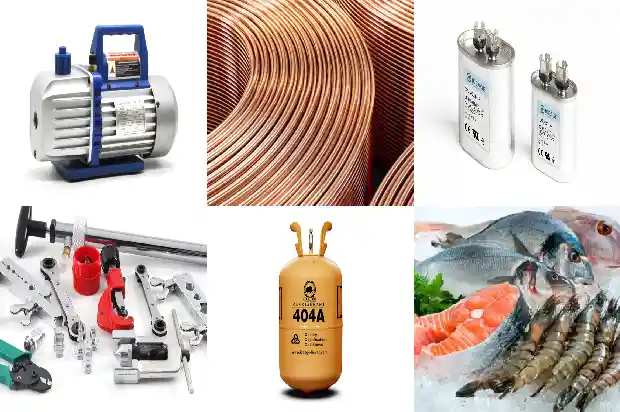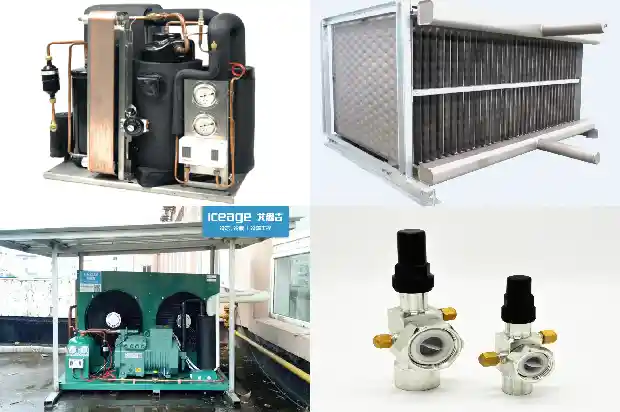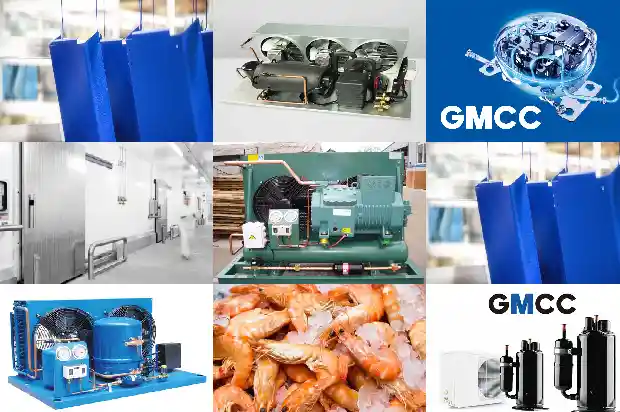Maintenance Strategies for the Working Cycle and Electrical Automatic Control of Chillers
2025-01-15
I. Working Principle of the Chiller
Industrial chiller units are composed of three interrelated systems: the refrigerant circulation system, the water circulation system, and the electrical automatic control system.
- Refrigerant Circulation System: The liquid refrigerant in the evaporator absorbs heat from the water and starts to evaporate. After completely evaporating into a gas state, it is sucked in and compressed by the compressor. The gaseous refrigerant absorbs heat through the condenser and condenses into a liquid. After throttling through the thermostatic expansion valve (or capillary tube), it becomes a low - temperature and low - pressure refrigerant and enters the evaporator, completing the refrigerant circulation process.
II. Basic Composition of the Refrigeration System
- Compressor: The compressor is the core component of the refrigeration system. Its function is to convert the input electrical energy into mechanical energy and compress the refrigerant.
- Condenser: During the refrigeration process, the condenser plays the role of outputting heat energy and condensing the refrigerant. The high - pressure superheated vapor discharged from the refrigeration compressor enters the condenser. The heat absorbed from the evaporator, the refrigeration compressor, and within the pipeline is transferred to the surrounding medium (water or air) and carried away. The high - pressure superheated vapor of the refrigerant re - condenses into a liquid.
- Receiver: The receiver is installed after the condenser and is directly connected to the liquid discharge pipe of the condenser. The refrigerant liquid from the condenser should flow smoothly into the receiver, so that the cooling area of the condenser can be fully utilized. On the other hand, when the heat load of the evaporator changes, the demand for refrigerant liquid also changes. At that time, the receiver plays the role of regulating and storing the refrigerant.
- Drier Filter: In the refrigeration cycle, it is necessary to prevent moisture and contaminants (oil stains, iron filings, copper filings, etc.) from entering. If the moisture in the system is not completely removed, when the refrigerant passes through the throttle valve (thermostatic expansion valve or capillary tube), due to the decrease in pressure and temperature, the moisture may sometimes solidify into ice, blocking the passage and affecting the normal operation of the refrigeration device.
- Thermostatic Expansion Valve: The thermostatic expansion valve is both a flow regulating valve and a throttle valve in the refrigeration system. It is installed between the drier filter and the evaporator in the refrigeration equipment, and its temperature - sensing bulb is wrapped at the outlet of the evaporator. Its main function is to throttle and reduce the pressure of the high - pressure and normal - temperature refrigerant liquid when it flows through the thermostatic expansion valve, turning it into a low - temperature and low - pressure refrigerant wet vapor.
It then enters the evaporator, vaporizes and absorbs heat in the evaporator, achieving the purpose of refrigeration and cooling.
- Evaporator: The evaporator is a heat - exchange device that relies on the evaporation of the refrigerant liquid to absorb the heat of the cooled medium. Its function in the refrigeration system is to absorb heat (or output cold). In order to ensure that the evaporation process can proceed stably and continuously, the evaporated gas must be continuously pumped away by the refrigeration compressor to maintain a certain evaporation pressure.
- Refrigerant: R22 is used as the refrigerant. Its role is to carry heat and achieve heat absorption and release during state changes.
IV. Water Circulation System
The water circulation system uses a water pump to pump water from the water tank to the equipment that needs to be cooled by the user. After the chilled water takes away the heat, its temperature rises and then returns to the chilled water tank.
V. Electrical Automatic Control System
The electrical automatic control system includes a power supply part and an automatic control part.
- Power Supply Part: The power supply part supplies power to the compressor, fan, water pump, etc.
through contactors.
- Automatic Control Part: The automatic control part includes components such as a thermostat, pressure protection device, timer, relay, and overload protection device. These components are combined to achieve functions such as automatic startup and shutdown according to water temperature, as well as protection.
VI. Pre - operation Work of the Industrial Chiller
- Installation Location: Install the machine in a sturdy place. To facilitate operation and maintenance, there should be a space of more than 1 meter around the machine. There should be no heat sources, harmful gases, steam, or flammable gases around to ensure that the machine is not polluted and can operate safely.
- Placement Considerations: The machine should be placed in a place close to the power source and the water supply source and where wiring is convenient. A drainage pipeline should be set up around the machine. If the machine is placed outdoors, a rain - proof and sun - proof shed should be erected.
- Ventilation Requirements: The place where the machine is installed should pay attention to ventilation and be equipped with exhaust equipment to ensure that the temperature around the machine does not exceed 35°C.
In frigid areas, it is necessary to ensure that the temperature around the machine is not lower than zero degrees to avoid freezing and damaging the machine.
- Pipeline Connection: The size specifications of the pipes connected to the machine should refer to the provisions in the technical parameter table and should not be changed arbitrarily.
- Power Connection: Connect the attached power cord (5m) with one end already connected to the switch of the control unit to the power supply. At this time, the grounding terminal (E) must be connected. Otherwise, there is a risk of electric shock due to misoperation, water leakage, or oil leakage accidents.
- Machine Water Supply: Close the drainage valve of the water tank, and open the water source valve, water supply valve, chilled water output valve, and chilled water input valve.
- Water Temperature and Flow Rate: Users should follow the data provided in the technical parameter table for the water temperature and flow rate of the cooling water and the refrigerant water. Otherwise, the machine will not work properly.
- Pre - operation Checks:
- Check whether the inlet and outlet valves of the mold are both open.
- Check whether the water volume in the chilled water tank is sufficient and whether the water replenishment and water supply are normal.
- Check whether the water volume in the entire piping system is sufficient and whether the air has been completely exhausted.
- Check whether the supply voltage is normal.
- Check whether the ground wire is firmly connected.
Related Articles
- Basic Faults and Preventive Maintenance of Water - cooled Units
- Essential for Maintenance! Parameters and Phenomena of Normal Operation of Refrigeration and Heating Systems
- Welding Equipment Used in Refrigeration System Maintenance
- Maintenance Methods for Small Modular Cold Storage Failures
- Maintenance Techniques for Air - conditioning Refrigeration Systems
- Essential Basics for Maintenance, Debugging of Refrigeration and Air - conditioning Systems
- 8 Maintenance Procedures for Industrial Chillers
- Requirements and Maintenance for Building Meat Food Cold Storage
- Maintenance Methods for Faults in Screw Refrigeration Air - conditioner Compressors
- Maintenance Methods for Refrigerant Leak in Air - conditioner Outdoor Unit
- Knowledge, Installation and Maintenance of Cold Storage Systems
- Are you familiar with the detection and maintenance methods of air conditioner components?
- Maintenance and Operation of Freezing and Cold Storage Warehouses
- Water-cooled Screw Chiller: Operation and Maintenance
- Daily Maintenance Training for Users after Installation of Small and Medium-Sized Cold Storages
- Maintenance of Screw Chiller
- Maintenance of Screw Chiller
- On the maintenance and inspection of external insulation layers of pipes in refrigeration devices
